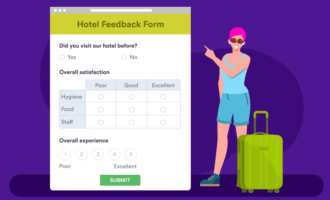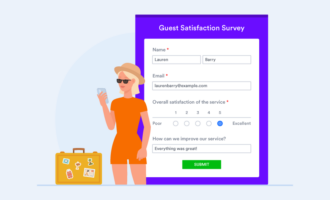Marketers, sales professionals, and other business leaders wish they could look into a crystal ball to see the thoughts, preferences, and needs of their customers. While this magic doesn’t exist, surveys can be the next best thing.
By collecting feedback directly from customers through surveys, businesses can make better decisions about product development, marketing strategies, and customer service — and even spot emerging trends in their industry. However, these potential benefits disappear when customers are influenced to answer survey questions a certain way or their answers are interpreted incorrectly.
The key to avoiding unhelpful responses is to prevent something called survey bias. Here’s what you need to know about survey bias — and how to avoid it.
How survey bias happens and how it impacts businesses
Survey bias is a phenomenon where the design, administration, or analysis of a survey skews the final results, causing a distortion of the data. The wording of questions, the placement of response options in a multiple choice question, and the demographics of a sample population can all contribute to survey bias. This can lead to inaccurate or misleading findings that do not reflect the actual opinions, behaviors, or attitudes of the participants.
When this occurs, leaders may make decisions for product development, marketing and sales strategies, and business development based on misleading data, hurting current revenue and future growth potential. Survey bias can skew results and undermine objective understanding of an audience (the purpose of conducting a survey to begin with), wasting time, resources, and money.
What survey bias looks like
Survey administrators can create the conditions for survey bias at any point in the design, distribution, and analysis of a survey. Here are some of the most common types of survey bias administrators need to watch out for:
- Selection bias: This type of bias occurs when the survey sample doesn’t accurately represent the target population. This can be the result of unintentional exclusion or failure to eliminate unqualified participants. For example, if a survey administrator conducts a survey on social media, relevant members of the population may not be able to participate if they don’t have an account on the platform. Alternatively, a survey on social media could open the floodgates to participants who aren’t necessarily a part of the target population.
- Non-response bias: Survey bias can occur even with a well-designed selection process. For example, non-response bias can happen when individuals within a chosen participant pool don’t submit their responses. The people who do respond may not accurately represent the larger population, resulting in an unintentionally skewed response.
- Response bias: Response bias refers to the tendency of respondents to answer questions inaccurately or in a socially desirable manner. For example, respondents might provide answers they believe are more acceptable or expected by the surveyor, leading to an overestimation or underestimation of certain behaviors or attitudes.
- Leading questions: When administrators word survey questions in a way that influences how participants respond, they create leading questions. For example, if a survey asks participants to rate their approval of a product by asking “How strongly do you agree that the product is excellent?” the participants may be subconsciously predisposed to answer positively. Avoid leading questions by phrasing surveys as neutrally as possible — for example, “How would you rate the quality of the product?”
- Order bias: Even the order of questions within a survey can cause bias. For example, respondents are naturally more likely to be influenced by the first few questions in a survey, framing perception of the questions that come later — even if that’s not the intention of administrators. Early questions can also stir up emotions, beliefs, and other conditions that influence how respondents answer later questions.
- Acquiescence bias: Acquiescence bias is a problem that can occur with surveys that use rating scales. It’s the tendency for participants to either agree or strongly agree with various statements without stopping to consider their authentic response. Often, this type of bias is based on a desire, whether conscious or not, to please the survey administrator.
How to prevent survey bias
Now that you know what survey bias is and how it can manifest, it’s important to take steps to prevent it from becoming a problem. Keep these tips in mind when designing a survey:
- Consider your sample representation. Carefully review the characteristics of your target population and ensure that the sample selection encompasses the breadth of that population.
- Use neutral language. Words or phrases that encourage a certain response can introduce bias into survey results, so carefully screen each question for neutrality. Make sure questions don’t make assumptions and are as clear and concise as possible.
- Randomize multiple choice answers. When creating multiple choice questions, randomize the response options for each participant to prevent the default order from encouraging bias.
- Maintain a balanced response scale. If you format question responses with a rating scale, the most extreme answers should be opposite each other. For example, if the strongest affirmative answer is “strongly agree,” then the strongest negative answer should be “strongly disagree.”
- Avoid complex questions. Make sure each survey question only asks about a single issue to avoid confusion or inconsistent responses.
- Conduct a pilot test. Before administering the survey to your complete sample selection, select a small group of representative respondents to take the survey and analyze their experience. This will give you a chance to correct any issues.
Surveys can offer insight into any target population, but administrators must be careful to avoid survey bias. Follow these guidelines to minimize the pitfalls of designing questionnaires and analyzing results.
Jotform, a leading online form builder, features a robust survey maker that’s ideal for creating bias-free questionnaires. Users can customize any of the platform’s 10,000 templates into a detailed survey and randomize question order and responses for multiple-choice questions. Conditional, branching logic even lets users create personalized survey paths, so respondents only answer relevant questions. And with a variety of data encryption and privacy features, Jotform is one of the most secure platforms available.
Photo by Mikhail Nilov






































































































Send Comment: